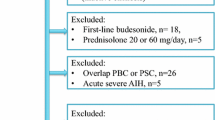Abstract
A retrospective cohort study involving 29 Japanese patients with autoimmune hepatitis (AIH) was performed to clarify factors that predict the efficacy of prednisolone and the occurrence of various serious adverse effects. Independent predictors were identified by logistic analysis and with use of the Cox proportional hazard model. Responses to prednisolone were noted in 28 patients, who were classified into the complete remission group (52%) or the relapse group (48%). Multivariate analysis identified alanine aminotransferase, alkaline phosphatase, and immoglobulin G levels as independent predictors of relapse. The adverse effects most frequently observed were diabetes mellitus (37.9%), psychiatric/ neurologic symptoms (34.5%), and circulatory symptoms (34.5%). Predictive factors included lactate dehydrogenase, albumin, and fasting blood glucose levels for diabetes mellitus, alkaline phosphatase and C-reactive protein for psychiatric/neurologic symptoms, and autoimmune hepatitis score and lactate dehydrogenase for circulatory symptoms. Selection of an optimal treatment method for individual patients may be possible after the risks of relapse and adverse effects have been estimated.
Similar content being viewed by others
References
Mackay IR, Weiden S, Hasker J. Autoimmune hepatitis.Ann NY Acad Sci. 1965; 124: 767–780.
Toda G. Revised criteria for diagnosis of autoimmune hepatitis.Intern Med. 2000; 39: 999–1000.
Toda G, Zeniya M, Watanabe F, et al. Present status of autoimmune hepatitis in Japan: correlating the characteristics with international criteria in an area with a high rate of HCV infection.J Hepatol. 1997; 26: 1207–1212.
Johnson PJ, McFarlane IG. Meeting report. International Autoimmune Hepatitis Group.Hepatology. 1993; 18: 998–1005.
Czaja AJ, Donaldson PT. Diagnosis and treatment of autoimmune hepatitis.Hepatology. 2002; 36: 479–497.
Alvarez F, Berg PA, Bianchi FB, et al. International Autoimmune Hepatitis Group report: review of autoimmune hepatitis.J Hepatol. 1999; 31: 929–938.
Czaja AJ. Autoimmune hepatitis. In: Feldman M, Friedman LS, Sleisenger NH, eds.Sleisenger & Fordtran’s Gastrointestinal and Liver Disease: Pathophysiology/Diagnosis/Management. Philadelphia, Pa: WB Saunders; 2002: 1462–1471.
Krawitt EL. Autoimmune hepatitis.N Engl J Med. 1996; 334: 897–903.
Czaja AJ, Donaldson PT. Genetic susceptibilities for immune expression and liver cell injury in autoimmune hepatitis.Immunol Rev. 2000; 174: 250–259.
Czaja AJ. Autoimmune hepatitis: evolving concepts and treatment strategies.Dig Dis Sci. 1995; 40: 435–456.
Czaja AJ, Beaver S, Shiels MT. Sustained remission after corticosteroid therapy of severe hepatitis B surface antigen-negative chronic active hepatitis.Gastroenterology. 1987; 92: 215–219.
Hegarty JE, Nouri-Aria KT, Portmann B. Relapse following treatment withdrawal in patients with autoimmune chronic active hepatitis.Hepatology. 1983; 3: 685–689.
Onji M, Nonaka T, Horiike N, Moriwaki H, Muto Y, Ohta Y. Present status of autoimmune hepatitis in Japan.Gastroenterol Jpn. 1993; 28: 134–138.
Milkiewics P, Ahmed M, Hathaway M. Factors associated with progression of the disease before transplantation in patients with autoimmune hepatitis.Liver. 1999; 19: 50–54.
Czaja AJ, Carpenter HA. Histological features associated with relapse after corticosteroid withdrawal in type 1 autoimmune hepatitis.Liver Int. 2003; 23: 116–123.
Czaja AJ, Bianchi FB, Carpenter HA, et al. Treatment challenges and investigational opportunities in autoimmune hepatitis.Hepatology. 2005; 41: 207–215.
Saag KG, Koehnke R, Caldwell JR, et al. Low dose long-term corticosteroid therapy in rheumatoid arthritis: an analysis of serious adverse events.Am J Med. 1994; 96: 115–123.
Blackburn WR, Kaplan HS, McKay DG. Morphologic changes in the developing rat placenta following prednisolone administration.Am J Obstet Gynecol. 1965; 92: 234–246.
Kawai S, Ichikawa Y, Homma M. Differences in metabolic properties among cortisol, prednisolone, and dexamethasone in liver and renal diseases: accelerated metabolism of dexamethasone in renal failure.J Clin Endocrinol Metab. 1985; 60: 848–854.
Stuck AE, Frey BM, Frey FJ. Kinetics of prednisolone and endogenous cortisol suppression in the elderly.Clin Pharmacol Ther. 1988; 43: 354–362.
Vermeulen A. The metabolism of 4–14C prednisolone.J Endocrinol. 1959; 18: 278–291.
Bergrem H, Ritland S, Opedal I, Bergan A. Prednisolone pharmacokinetics and protein-binding in patients with portosystemic shunt.Gastroenterology. 1983; 18: 273–276.
Meyerzum Büschenfelde KH, Manns M. Immunological investigations in liver diseases. In: McIntyre N, ed.Oxford Textbook of Clinical Hepatology I. New York, NY: Oxford University Press; 1991: 315–320.
Thomas HC. Immunologic aspects of liver disease. In: Schiff L, Schiff ER, eds.Diseases of the Liver I. Philadelphia, Pa: Lippincott; 1993: 638–658.
Yoneyama K, Taniguchi H, Kiuchi Y, Shibata M, Mitamura K. Prognostic index of liver cirrhosis with ascites with and without hepatocellular carcinoma.Scand J Gastroenterol. 2004; 39: 1272–1279.
Yoneyama K, Nebashi Y, Kiuchi Y, Shibata M, Mitamura K. Prognostic index of cirrhotic patients with encephalopathy with and without hepatocellular carcinoma.Dig Dis Sci. 2004; 49: 1174–1180.
Czaja AJ, Menon KV, Carpenter HA. Sustained remission after corticosteroid therapy for type 1 autoimmune hepatitis: a retrospective analysis.Hepatology. 2002; 35: 890–897.
Takenami T, Sakaguchi K, Nishimura M, et al. Therapeutic effects of azathioprine in combination with low-dose prednisolone in patients with intractable autoimmune hepatitis type 1.Acta Med Okayama. 2001; 55: 341–347.
National High Blood Pressure Education Program Working Group. National High Blood Pressure Education Program Working Group report on hypertension in the elderly.Hypertension. 1994; 23: 275–285.
Madhavan S, Ooi WL, Cohen H, Alderman MH. Relation of pulse pressure reduction to the incidence of myocardial infarction.Hypertension. 1994; 23: 395–401.
Author information
Authors and Affiliations
Rights and permissions
About this article
Cite this article
Yoneyama, K., Honda, E., Kogo, M. et al. Efficacy and safety of prednisolone in patients with autoimmune hepatitis. Adv Therapy 23, 74–91 (2006). https://doi.org/10.1007/BF02850349
Issue Date:
DOI: https://doi.org/10.1007/BF02850349




